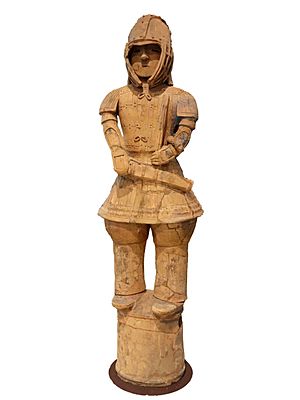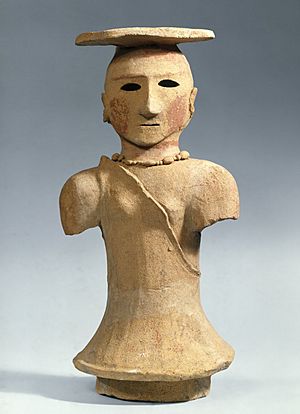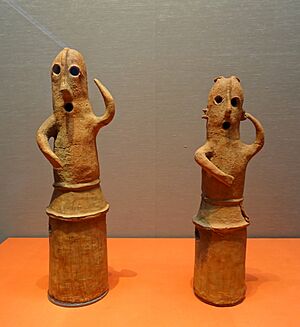Haniwa facts for kids
The Haniwa (埴輪) are special clay figures from ancient Japan. People made them for rituals and buried them with the dead. These figures were used during the Kofun period, which lasted from the 3rd to the 6th centuries AD.
Haniwa were made from water-based clay. The clay was coiled up, layer by layer, to form the figures. Then, they were dried to make them strong and long-lasting. Their name means "circle of clay." This is because they were often placed in a circle around a tomb. Smaller parts, like arms or tools, were made separately and then attached.
During the Kofun period, Japan had powerful rulers and a strong military. Warriors rode horses and used iron armor, swords, and other weapons. Many Haniwa figures show these warriors and their equipment.
Most Haniwa were found in southern Honshū, especially near Nara, and in northern Kyūshū. These figures came in many shapes. There were Haniwa of horses, chickens, birds, and even houses. They also depicted weapons, shields, and people. Besides being decorative, they were believed to protect the dead in the afterlife. They also helped hold up the burial mounds.
Haniwa are very important for understanding the Kofun period. They show us what people wore, how they styled their hair, what farming tools they used, and what their buildings looked like.
Contents
What Haniwa Were For
Originally, the simple, cylinder-shaped Haniwa were placed on top of funeral mounds. People believe they were part of funeral ceremonies. As Haniwa became more detailed, they were placed around the outside of the grave area. They might have been used to mark the edges of the burial site.
Some people believe that the soul of the person who died would live inside the Haniwa. This idea comes from how early Haniwa were placed right on top of the funeral mounds. Some Haniwa even have weapons and armor. These armored figures were thought to hold souls and protect the buried ruler from bad spirits or danger. Horse and animal Haniwa were often lined up neatly. This suggests they were part of a ceremony to send off the deceased.
Haniwa in Modern Times
Today, Haniwa are not used for religious purposes as much. However, many people love them for their beauty and historical value. Famous artists, like Isamu Noguchi, were inspired by Haniwa. Time magazine even called them "Pure Art." In popular culture, Haniwa are sometimes shown as having a spirit or being alive, not just empty statues.
Haniwa in Video Games
Haniwa figures have appeared in many video games:
- Animal Crossing — Haniwa are called Gyroids in the English version. You can find them buried in the ground and use them as furniture. A Gyroid named Lloid helps collect donations for town projects.
- Dragon Quest — Earthenwarriors are common enemies. They are small clay figures riding horse statues, looking a lot like real Haniwa.
- Fantasy Life — There's a place called "Haniwa Cave." In one spot, you can see a Haniwa-shaped hill that looks like it's dancing.
- Final Fantasy Legend II — "Haniwa" is a very tough optional boss with a lot of health and strong attacks.
- Final Fantasy (series) — The Cactuar character has a face like a Haniwa and poses like the dancing figures. Cactuars have appeared in many other games too.
- Kirby (series) — "Cappies" are common enemies. They wear mushroom hats, but if Kirby inhales the hat, you can see their Haniwa-like face and dancing pose.
- Super Smash Bros. for Nintendo 3DS and Wii U — Villager, from Animal Crossing, can summon an explosive Gyroid as an attack.
- Super Smash Bros. Ultimate — Isabelle can plant a mine that looks like a Gyroid. When triggered, it pops up and damages enemies.
- Touhou Kikeijuu ~ Wily Beast and Weakest Creature — Mayumi Joutouguu is a boss who leads the Haniwa Army Corps. Her clothing looks like ancient Japanese armor. She explains that things crafted by her creator have souls, similar to the belief that Haniwa held souls.
Haniwa in Trading Cards
- Yu-Gi-Oh! — "Haniwa" is a Monster card. It's an Earth-attribute, Rock-type monster shown in a dancing pose.
Images for kids
-
Haniwa horse statuette, complete with saddle and stirrups, 6th century
See also
 In Spanish: Haniwa para niños
In Spanish: Haniwa para niños







